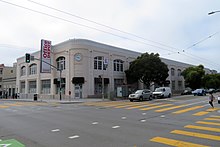Geary Street, Park and Ocean Railway
| Geary Street, Park and Ocean Railway | |
|---|---|
 The former carbarn at Arguello Street in 2018 | |
| Overview | |
| Locale | San Francisco, California |
| Transit type | cable cars |
| Operation | |
| Began operation | 1880 |
| Ended operation | 1912 |
| Operator(s) | Geary Street, Park & Ocean Railway (1880–1887), Market Street Railway (1887–1912), San Francisco Municipal Transportation Agency (1912–present) |
| Technical | |
| Track gauge | 4 ft 8+1⁄2 in (1,435 mm), |
| Old gauge | 5 ft (1,524 mm), converted in 1892 |
The Geary Street, Park and Ocean Railway was a street railway in San Francisco.
History[]
Operations commenced on February 16, 1880 as a Russian gauge tram pulled by steam dummy locomotives. The route soon proved quite popular.[1] The line was purchased by the Market Street Railway in 1887.[2]
In 1912, the city declined to renew the franchise and instead took over operation of the Geary Street railway.[3] The line was converted into an electric streetcar line, forming the first element of the San Francisco Municipal Railway (Muni) that was to come to be synonymous with transit in that city. Muni replaced the street cars with motor coaches in 1956. Today, the bus routes that serve the Geary corridor are the most heavily used in San Francisco.[4]
Infrastructure[]
Cars terminated downtown at Geary, Market, and Kearny Streets.[5] The powerhouse was in a two-story wooden building on the northwest corner of Geary Boulevard and Buchanan Street.[6] The car barn was in a building on the northwest corner of Geary Boulevard and Arguello Boulevard, later an Office Max store.[7]
Rolling stock[]
Baldwin Locomotive Works built four 0-4-0 tank locomotives for the line. Numbers 1 and 3 (C/N 4801 & 4817) had vertical boilers while numbers 2 and 4 (C/N 4827 & 5115) had more conventional horizontal boilers. The two locomotives with horizontal boilers were sold to redwood logging railroads when line was converted to cable car operation on August 7, 1892. Locomotive #2 became #6 for Hobbs, Wall & Company of Crescent City, California; and #4 was sent to the Glen Blair Redwood Company on the California Western Railroad.[8]
See also[]
References[]
- ^ Thompson, Joe. "The Cable Car Home Page - Geary Street Park and Ocean Railway". Retrieved December 24, 2007.
- ^ "Cable Car Company - Geary Street Park & Ocean Railroad". Cable Car Museum. Retrieved December 24, 2007.
- ^ LaBounty, Steve W. "Run Out of Town - Western Neighborhoods Project". Retrieved December 24, 2007.
- ^ "Transit Effectiveness Project (TEP) Data". San Francisco Municipal Transportation Agency. Archived from the original on July 19, 2008. Retrieved August 19, 2008.
- ^ Trimble, Paul C. (2004). Railways of San Francisco. Arcadia Publishing. p. 18. ISBN 9780738528878.
- ^ LaBounty, Woody (May 2002). "Streetwise: Run Out of Town". outsidelands.org. Western Neighborhods Project. Retrieved October 25, 2020.
- ^ "Geary Street Car barn, Geary Street Park & Ocean Railway". outsidelands.org. Western Neighborhoods Project. Retrieved October 25, 2020.
- ^ Borden, Stanley T. (1971). "San Francisco Steam Dummies". The Western Railroader. Francis A. Guido. 34 (376): 3.
- Public transportation in San Francisco
- Streetcars in California
- Tram, urban railway and trolley companies
- Cable car railways in the United States
- Defunct public transport operators in the United States
- Defunct California railroads
- 5 ft gauge railways in the United States
- 1880 establishments in California
- 1912 disestablishments in California
- Tram stubs
- California transportation stubs